cross-curricular connections
At the Zooseum
A field trip experience is strenghthened with a project focusing on adaptations
Science and Children—January/February 2023 (Volume 60, Issue 1)
By Bonnie Glass, Sara Dail, Nicole Ahn, and Tammy Lee
“I want the polar bear!” shouted students as the wheel of animal names on the computer screen spun. Anticipation grew as a student landed on the giraffe. The next animal did not elicit quite the same enthusiasm. “What is a Gila monster?” chorused several children. The excitement was palpable as students were randomly assigned animals found in our state zoo. Thus began their journey to build our fourth-grade Zooseum—one part-zoo, one part-museum.
Science represents both a body of knowledge and the process by which scientists learn about the world. Students need experience thinking and doing what scientists do, so as educators, we must engage them in the practices of scientists. Through this project students were engaged in the following practices as outlined by the Framework (NRC 2012):
- Obtaining, evaluating, and communicating information—What are the animal’s unique structures, and how do they function to promote survival? What sources do I use for my research, and how do I communicate my findings about my animal’s unique structures and their functions through an audio presentation?
- Developing models—How can I best represent my animal’s unique adapted structures in my paper mache model?
Having taken our annual field trip to the zoo for several years and having tried various lessons to engage students in observing and understanding animal adaptations, we wanted to create a more meaningful and memorable experience. Working with our arts teacher, we created the student-centered interdisciplinary project explained here. This project promoted deeper understanding of the science behind animal adaptations, integrated literacy and art, and engaged students in the design process of the student-created exhibits. Not only did this project impact our students’ science learning, but through our Zooseum, we educated our school and community, too.
Project Overview
Our Zooseum project consisted of the following:
- Engage: Creating Adaptation Bingo
- Explore: Observing animals and their adaptations at our state zoo
- Explain: Researching assigned zoo animals
- Elaborate: Creating 3D paper-mache models and QR-coded talks to educate Zooseum visitors on animals’ adaptations
- Evaluate: Visiting our Zooseum and reflecting on the experience
This first iteration of the project required 15 (50-minute) science class periods, but due to its cross-curricular connections, this project could be completed during scheduled language arts and art instructional time.
Aside from the zoo trip, this project was quite inexpensive (although the final products tell a different story). For the paper mache, we used white school glue and water and tore donated newspapers into strips. A roll of dollar store foil was used to construct antlers for bison and gazelles. Each student brought in a roll of masking tape to share, and there were plenty to spare. Acrylic paint, brushes, cardboard, and duct tape were also required. Optional items were purchased at the dollar store, such as fake eyelashes and fishing line, which helped add that “wow!” factor to our exhibits.
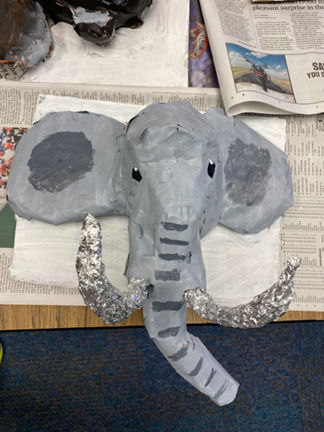
Day 1: Engage
Prior to this project, students participated in several class discussions and activities exploring animal adaptations, including Camouflage Capers and a bird beak investigation. We also watched a TED Talk on hummingbirds (see Online Resources). Through these experiences and previous instruction, students had developed understandings of the terms structure, function, and adaptations. Now that students were familiar with these concepts, we were ready to create our Zooseum.
Students were introduced to the Zooseum project the day prior to our field trip to the state zoo. We discussed that our zoo has the unique distinction of being the world’s largest “natural habitat” zoo. Students were engaged in a conversation focusing on the following questions: What is meant by a “natural habitat” zoo? What might the animal habitats look like? What kinds of animals might we expect to see? What are some adaptations these animals might have? As a class, we generated a list of animal adaptations. Students contributed adaptations such as whiskers, pointed beaks, hooves, and so on. From this list, the teacher created an “Adaptation Bingo” for students to complete at the zoo (see Supplemental Resources).
Excitement grew as students were assigned a zoo animal using a random sorter. Together we discussed the project requirements and reviewed the scoring guide (see Supplemental Resources). Finally, students were challenged to carefully observe their assigned animals when we visited the zoo.
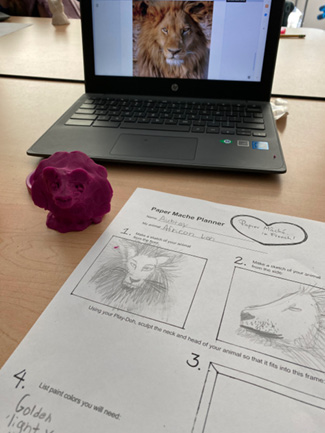
Day 2: Explore
Zoo day! Students spent this day touring the zoo in chaperoned groups. Field trips including experiential learning, like our trip to the zoo, have been an important tradition in education because of their ability to yield a variety of cognitive, affective, social, and behavioral impacts that contribute to learning (Tal and Morag 2009). As a “natural habitat zoo,” our state zoo covers 2,600 acres. Students traversed the paved trails in groups, visiting the various simulated habitats. Although it is not always feasible to take field trips such as this, nature-based experiences have shown to have a long-term impact on students’ recall of themes and meanings of the experiences (Farmer, Knapp, and Benton 2007).
As students explored different animal habitats, they searched for the adaptations listed on their “Adaptation Bingo” cards. They marked off squares on their cards as they spied these structures, recording in the square the name of the animal that possessed the adaptation. As they toured, they found their assigned zoo animal and observed this animal in its habitat. They experienced first-hand the Sonoran Desert environment created beneath the dome with its dry air and warm temperatures. They contrasted this with the simulated arctic environment housing the puffin and polar bear exhibits. They noted characteristics of their animal’s habitat and identified specific traits that supported their animal’s growth and survival in it. As a part of this field experience, students recorded observations of their animal’s unique physical structures and behaviors on their “Adaptation Bingo” sheets. This experience created the foundation for building their explanations of their animals’ adaptations. Note: If traveling to the zoo is not feasible, many zoos have virtual field trips/virtual tours that offer a great time and money-saving alternative.
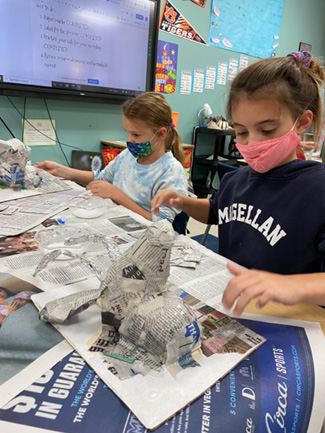
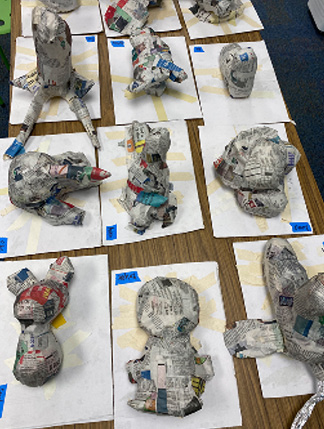
Days 3–6: Explain
Back at school, we began our research phase of the project. First, we debriefed our zoo experience, with students sharing observations regarding their animals’ habitats and adaptations. Recognizing our students have different reading levels, the research phase was structured to promote the success of all learners through assignment scaffolding and teacher modeling. Prior to beginning research, the students were guided through a slideshow template. Students were instructed to fill in the template using the provided list of acceptable websites (see Supplemental Resources). To begin each day of research, the teacher modeled how to complete an assigned slide by filling in the template based on her animal, the puma. She showed students how to toggle between websites and slideshows in their Chromebooks when collecting research.
Students used the next three days to research and complete their slides. Students had to select appropriate information to accurately and sufficiently address the topics on each slide of the template. Students concentrated their research on identifying internal and external structures and how these structures function to support their specific animal’s growth, survival, behavior, and reproduction. They focused on gathering information on animals’ physical features, how these features dictate certain behaviors relating to how animals obtain food and how they maintain relationships with other animals, plants, and abiotic features within their specific habitats. Students identified specifically how each structure functions to provide a survival or reproductive advantage for their animal.
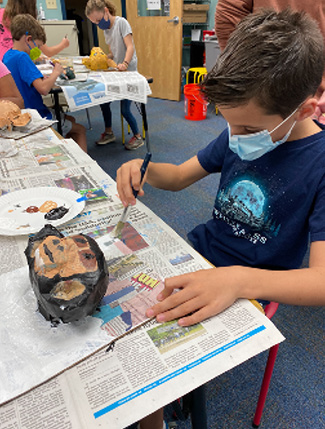
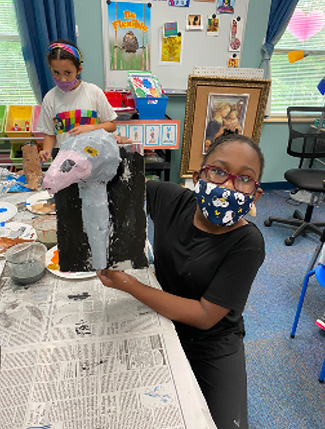
Day 7–13: Elaborate
These days were set aside to focus on our models. In this phase of the project, students used their research to create models of their animals to provide explanations and to communicate ideas to others. During model building, students used their knowledge of the animal’s specific structural adaptations when making decisions about how to best represent them in their design process. They asked themselves, for example: What special structures did the animal have (tusks, antlers, whiskers, trunks, etc.)? Where were its eyes? What color was its coat? How did these structures help the animal grow, survive, and reproduce in its habitat?
The art teacher provided expertise in building our models. She introduced this phase of the project using a slideshow that explained the steps. Students selected pictures to refer to as they first sketched their animal’s head and neck. Next, they practiced sculpting their animals using modeling clay. Students were instructed to focus on each animal’s unique structures and how to best model these. Having researched how the external structures of each animal provided important survival and reproductive advantage, they carefully sculpted their animals. After practicing with clay, students created their armatures (the support structure underneath the paper mache) using newspaper and masking tape. The newspaper was made more pliable by crumpling one sheet at a time then opening it up and smoothing it out. Students had a great time prepping their materials with this energetic task. The pliable newspaper was then sculpted, with animal head shape in mind, adding layer upon layer. Once a desired shape was achieved, it was secured with masking tape. Structures like necks, ears, trunks, and horns were made separately then attached to the head with tape. When completed, newspaper armatures were taped to the mounting cardboard.
Now it was time to get messy! Newspaper strips of varying lengths were prepared in advance. Shorter pieces were easier to start with, and longer strips were used later for wrapping around shapes and to cover the masking tape securing the animal bust to the board. Each student was given a shallow bowl of medium (one part white school glue to one part water). Rather than dip the newspaper, students dipped three fingers into the medium and wet the piece of newspaper until it was translucent. This method kept the sculptures from getting too soggy, allowing the art to dry quickly. In most cases, one layer of paper mache was sufficient.
On the fifth day, students applied the finishing layer of paper mache, and on day six, dried sculptures were painted using acrylic paint. Students were reminded that animal’s coloration is an adaptation and were encouraged to carefully select colors to best represent this important feature. With help from grownups, models were “framed” with colorful duct tape. The “frame” added whimsy and color and changed the look from “trophy-mounted animal head” to “animal popping out of a frame.” Note: Model-building days were made more manageable by having one to two parent volunteers. Students were immersed in the experience, so, although management of student behavior was not an issue, having an extra pair of hands was helpful. Storing projects took some finagling, but between the two teachers’ classrooms and some utility carts, we found a home for every exhibit-in-progress!
Students were wholly engrossed in the model-building process and proud of their animal representations saying things like, “I love getting messy!” and, “Oh my gosh! My ostrich is beautiful!” The final day of model-making was set aside for finishing touches. Ostriches and giraffes got false eyelashes from the dollar store, seals were adorned with fishing wire whiskers, etc. These days of model creation were memorable, messy, and fun!
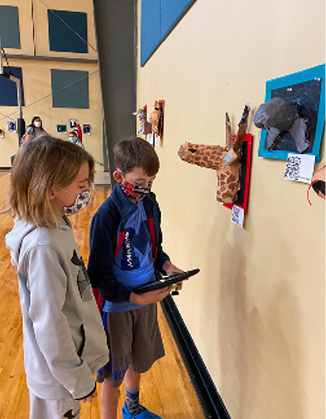
Days 14–15: Evaluate
Following their model building phase, students completed their exhibits by explaining in an audio-recorded presentation how their animals’ unique structures provided them survival advantage. Communicating explanations provides students rich opportunities for language development while concurrently promoting science learning (Lee, Quinn, and Valdés 2013). Engaging in this phase of the project reinforced language skills and supported student understanding of behavioral and structural adaptations. The students were instructed to use their research to create “talking points” to guide the creation of their audio presentations. The “talking points” focused on the animal and habitat as well as an explanation of the importance of the animal’s physical and behavioral adaptations that provide the animal with advantages in its natural habitat. Students were provided with a video explaining how to record their talks using a simple online voice recording program called Vocaroo (vocaroo.com). The teacher also modeled using the program as she recorded her puma talk. After successfully recording their talks, students printed the QR code that Vocaroo generates and attached it to an index card labeled with each animal’s name (see Supplemental Resources for a sample talk). To complete each exhibit, index cards were attached to the paper-mache animal boards. The exhibits were then displayed throughout the gym in preparation for the Zooseum the following day. The entire process, from student zoo observations, to their research on animal adaptations, to their thoughtful modeling of their animals, enhanced student understanding of how certain structures supported their animal’s success.
The day had finally come! Invitations to visit the Zooseum were extended to parents as well as the rest of the school. Fourth-grade students were especially excited to tour the Zooseum they had worked so hard on. Students were stationed throughout the gym with a partner and an iPad to share. They spent the class period journeying through the Zooseum, scanning QR codes and marveling at the animals as they listened to their friends’ recordings and admired their work. After touring the Zooseum, students snacked on animal crackers as they reflected on their Zooseum experience, recording their thoughts on individual reflection sheets (see Supplemental Resources). In their reflections, they each chose a favorite adaptation, one writing, “Long eyelashes on the ostrich to block a lot of dust from getting in them. They are my favorite because they would be very helpful if I had them,” and another saying, “The camouflage skin that the Gila monster had mostly to hide from other predators.” Students celebrated the efforts of their peers, one writing, “The best part of the Zooseum was seeing everybody’s work and admiring it because everyone put soooo much work into what they made.”
Building a Zooseum was an adventure as well as a big commitment of instructional time. Watching the students’ excitement throughout this journey made it apparent that the time spent was worthwhile. Students had begun by carefully observing their animals in their habitats as they toured the zoo. Through their observations and research, they explored the uniqueness of their animals and developed explanations of how these traits provided survival and reproductive advantage. They communicated these explanations in their exhibit creation, thoughtfully considering how to best model and explain the significance of these structures and how they functioned to support each animal’s survival. Student learning and engagement in all parts of this project, from the computer-generated assignment of animals, our zoo trip, their exhibit creation and finally to their Zooseum visit, was off the charts. Students were captivated by the entire experience, and their products were truly amazing!
Online Resources
Camouflage Capers (Queensland Museum Network): https://learning.qm.qld.gov.au/resources/1639163
Ted Talk: The Surprising Secrets of Hummingbird Flight: www.youtube.com/watch?v=1Lt3nd4QKy4
Vocaroo: https://vocaroo.com
Wheel of Names Sorter: https://wheelofnames.com
Supplemental Resources
Download the adaptation bingo gameboard, scoring guide, list of acceptable websites, reflection sheet, and access a sample talk at https://bit.ly/3URzvMN.
Bonnie Glass (Glassb@ecu.edu) is a senior teaching instructor at East Carolina University in Greenville, North Carolina. Sara Dail and Nicole Ahn are teachers at Magellan Charter School in Raleigh, North Carolina. Tammy Lee is an associate professor at East Carolina University.
Biology Crosscutting Concepts Life Science


